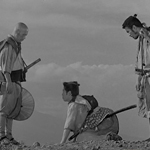 There are some movies that everybody knows are great and you’d be a fool to deny it. One such movie involves a group of cooperating samurai numbering seven. This is their review.
There are some movies that everybody knows are great and you’d be a fool to deny it. One such movie involves a group of cooperating samurai numbering seven. This is their review.
1954 was a pretty good year for film. Many of the films that were popular in the U.S. are still watched and discussed today: REAR WINDOW, WHITE CHRISTMAS, 20,000 LEAGUES UNDER THE SEA, CARMEN JONES. The best picture/director/actor/supporting actress winner was ON THE WATERFRONT, a movie that turned out to be, you know, fairly influential for actors. In Japan, meanwhile, the two biggest hits were WHAT IS YOUR NAME?: PART 3 and CHUSHINGURA: HANA NO MAKI, YUKI NO MAKI. I don’t think those ever made it to video over here, and little information exists about them in my usual reference sources. The first one appears to be a romance sequel and the latter sounds like it would have something to do with the 47 RONIN story.
In third place at the Japanese box office that year, though, was Akira Kurosawa’s SEVEN SAMURAI. It was his fifteenth movie, but his first samurai movie. Would you believe it made more money than the original GODZILLA, which also came out that year? Doesn’t matter now. Both have persevered. And SEVEN SAMURAI is a movie justifiably worshiped by snooty film buffs (and in the Criterion Collection) while still being hugely influential in all the lower-brow genres I love: martial arts, westerns and straight up action.
People always complain about long movies, but here’s a nearly 3 1/2 hour one (the longest of Kurosawa’s career) that’s never a chore to watch. It’s a great story, simple and elegant, but it takes the time to let us get to know its characters, and to give us that feeling of waiting. Some day after the barley is harvested bandits will attack the village. We want that day to come and be over with but we also want all the time we can to get ready.
If you haven’t seen this movie, I’m proud to be the latest one to remind you that you need to see this movie. You need to. Everybody else, you know the story, but let’s go over it in case it’s been a while.
A farmer spots some bandits peeping out his village. He eavesdrops as they consider attacking it, but then remember they already took all the rice last year, and decide to come back when the barley crop comes in.
With this information, the people of the village argue about how to deal with the bastards this time. Do they have a choice but to give in yet again? They come up with a desperate plan to pool their meager belongings – crowdfund, basically – and hire some samurai to protect them.
A few of the farmers go into town, and there are plenty of ronin wandering in this wild post-war time, but anybody worthwhile turns their noses up to the lowly peasants and their pathetic offer of mostly food. This situation is very familiar to anybody who runs a bar or music festival and has to find good bands that will play in exchange for beer tickets. But they hope eventually they’ll find a samurai who’s starving.
They witness a volatile hostage situation. Word is a robber almost got caught and pulled some kid into a barn. A crowd is gathered watching a monk give a guy a haircut. I love the mysterious suspense of this scene. What is going on here? Turns out this is Kambei (Takashi Shimura, KAGEMUSHA, GODZILLA), an old ex-samurai who asked this monk to cut his hair and loan him his robes. He uses the monk disguise to get into the barn and save the girl.
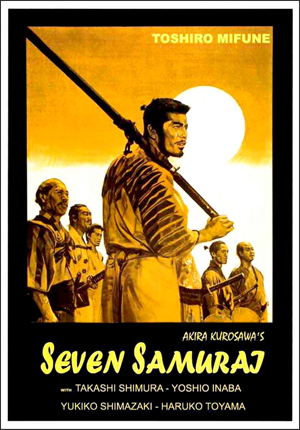 It’s such a brilliant introduction, because he does this clever, badass thing, and then he gets to have the shaved head for the rest of the movie. Not having a topknot, he is symbolically freed to break with samurai tradition and accept this job that the others have rejected. He continues to resemble a monk, which fits his wisdom and demeanor. He runs his hands over his head stubble when he’s deep in thought. And at the very end, since his hair is a little longer, we know some time has passed.
It’s such a brilliant introduction, because he does this clever, badass thing, and then he gets to have the shaved head for the rest of the movie. Not having a topknot, he is symbolically freed to break with samurai tradition and accept this job that the others have rejected. He continues to resemble a monk, which fits his wisdom and demeanor. He runs his hands over his head stubble when he’s deep in thought. And at the very end, since his hair is a little longer, we know some time has passed.
This scene also seems like a precedent for later action movies. Hero cop characters especially are often introduced with an unorthodox handling of a crime in progress. In DIRTY HARRY Callahan foils a bank robbery during his lunch (while still chewing), in LETHAL WEAPON Riggs does his smartass drug sting turned Three Stooges routine, in BEVERLY HILLS COP Axel Foley is undercover with untaxed cigarette smugglers and gets involved in a truck chase.
(Now that I’ve written about this I see that Roger Ebert pointed it out a long time ago, but it’s important to me. I’m keeping it.)
Right after that Kurosawa may have invented another important trope: the recruiting montage. Once they convince Kambei to help he speaks with and tests a series of applicants, he goes around and scouts for fighters, gets them to join up one at a time, building his ragtag team of guys who are both badass enough and desperate enough to consider this gig.
So it’s the perfect men on a mission movie. They are both the great warriors and the scrappy underdogs, because they have valuable skills but they’re a mix of out of practice and inexperienced. The story is about this team coming together, figuring out how to train the villagers to fight (including training montage), strategizing about how to set things up. It’s this gimmick that’s always been so enjoyable about the old warriors who draw upon their elite skills to help out regular people, which has since come up in everything from STAR WARS to The A-Team and The Equalizer. But those later stories don’t tend to deal as much with the culture clash. Before they can all fight together they have to soothe the disagreements between the samurai and with the villagers, who have many different resentments.
This village is a community that has been mistreated again and again by the samurai, so it shouldn’t be a surprise that they’re afraid of them and reluctant to work with them. I’m sure they usually practice a no snitching policy.
I think one conflict that applies to today is when the samurai are outraged that the villagers have armor and weapons that they think must’ve been stolen from dying samurai. They react with righteous indignation. Until Kikuchiyo (Toshiro Mifune) lectures them about what it’s like to be a farmer terrorized by samurai (revealing his true background) they’re incapable of considering it from that perspective. Of course this isn’t a one-to-one analogy, but it reminds me of today’s police unions when they try to bully, shame and shut down anyone who criticizes them, rather than try to communicate with and have an understanding of the communities they work in. They make it seem like an unbridgeable gap between the police and the citizens by treating any discussion of any of their shit not stinking as outrageous and indefensible treachery. We need more Kikuchiyos among them to straighten them out.
That’s not to say the villagers are perfect, either. When they capture a scout and beat him to death it’s against the objections of the samurai. Not cool, villagers. This is how Freddy Kruegers are made. Also, the samurai are more liberal than some of the farmers about relationships. They have to calm down this old guy Manzo (Kamatari Fujiwara, HIDDEN FORTRESS) when he finds out his daughter Shino (Keiko Tsushima) got it on with a samurai.
In fact, this attitude goes back to the way samurai have traditionally treated villagers. Manzo is so convinced these seven will want to rape his daughter that he forces her to dress as a man. When she’s discovered by Katsushiro (Isao Kimura, BLACK LIZARD, LONE WOLF AND CUB: WHITE HEAVEN IN HELL) and they fall in love she knows it’s forbidden for a samurai and a farm girl to be together. So her way of coming on to him is laying back and hoping he’ll force himself on her. You know, like samurai do. This is fucked up and I’m very proud of the young man for not wanting anything to do with that shit.
The men of the village have a great shame about their helplessness against the bandits. Maybe the most horrifying turn in the movie is when Rikichi (Yoshio Tsuchiya) guides the samurai to the bandit village and comes across his wife. She takes one look at him and walks back into a burning building. I’m thinking this motherfucker gave her to them last year to appease them. Whatever he did, it is not forgiven.
It’s a movie with that kind of powerful tragedy, and yet it’s fun and full of laughs, many courtesy of Mifune. Somehow I never realized that this was made seven years before the simpler, smaller YOJIMBO and SANJURO. In those Mifune’s character likes to fuck with people, and he has fleas, but Kikuchiyo is an even more comedic character. A weirdo, often a buffoon, with a distinctly monkey-like way of moving, a love of putting on pieces of armor he found, like a kid playing dressup, and sometimes giggling during battles. If you think about it he’s doing something similar to what Johnny Depp did in PIRATES OF THE CARIBBEAN, adding this weird, intoxicated trickster into an otherwise serious story.
I love the scene where everybody watches Kikuchiyo attempt to ride the village’s most notoriously wild horse. They’re impressed that he’s able to do it for a second, and then they get a laugh when he gets bucked off. It’s a good scene on its own but also sets up the later one where a bandit steals a horse thinking it will be a good way to escape. Whoops.
But Kikuchiyo goes deeper too. He gets some of the most emotional moments of the movie as his past gives him the most personal attachment to the plight of the farmers. And when he rescues a baby from a fire he breaks down remembering that this is how he was orphaned.
Some of this is like a hangout movie. We love just being with these guys. There’s a sense of them revisiting the old days, having a mission like this, and a sense of community as they get to come together with other warriors and form a team. The more experienced samurai have sort of a fatherly or big brotherly relationship with young rookie Katsushiro, teasing him, helping him, and taking pride in him as he advances. They even get to laugh together about him “becoming a man” by losing his virginity.
This bond also makes the movie very emotional, because they know this is an uphill battle, and this isn’t THE EXPENDABLES. The majority of the seven will not survive the battle, and it will be upsetting. Especially poor Heihachi (Minoru Chiaki, GODZILLA RAIDS AGAIN), who seemed to be a lesser talent on the team, but his enthusiasm was crucial for morale. He insisted on creating a banner to represent the team (like some dork designing a logo and printing custom t-shirts for his friends), so when that thing is raised after his death it’s one of those great misty-eyed movie moments for me. Grief and joy combined.
It’s a sad but beautiful ending. What could be a more elegant way to conclude a movie called SEVEN SAMURAI than three samurai standing below four kitana-bearing burial mounds? While the village celebrates, they talk solemnly.
“So, once again we have survived,” Kambei says. Almost like he’s disappointed they made it. Now they might have to go through it again some day.
When all is said and done I think the crucial part of this story is something very simple that’s established at the very beginning: the class difference. Even though they are scattered and unaffiliated after the war, the samurai are a higher class than the farmers. At the beginning most of the farmers think there’s no chance in hell that a samurai would want to help them, and many of those that they approach support that assumption.
That’s what makes these seven samurai so admirable. They are a class of highly trained warriors whose purpose in life is to fight on behalf of royalty. In the past they would’ve proudly died in service of their emperor. That didn’t work out so well for them, and now they choose to give their lives to protect some peasants, in exchange for some rice. That’s deep.



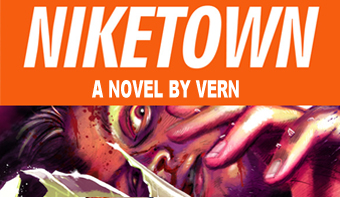
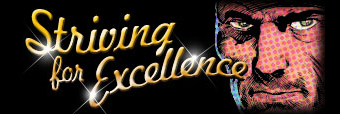
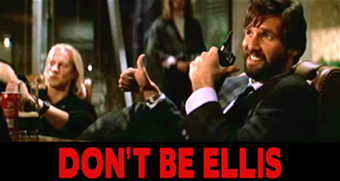

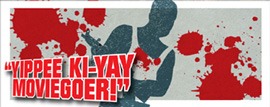








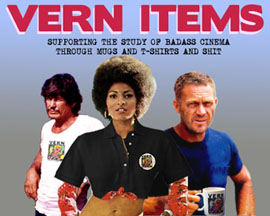









September 21st, 2016 at 12:29 pm
This is one of the all-time greatest, no question. This was my introduction to Kurosawa and it’s still my favorite of his. The long running time means that the tension builds and builds as the team forms and starts to escalate their confrontations with the bandits — by the time the giant battle kicks into gear at the end it feels like this crazy catharsis. The moment that sticks in my mind is from that final battle, with horses rearing and chaos filling the screen — Takashi Shimura’s character calmly drawing his bow and placing his shots. Talk about a badass moment in cinema! (For anyone who is interested in learning about Kurosawa and Mifune’s partnership, there is a great “double biography” titled The Emperor and the Wolf, which tells both of their life stories. Totally fascinating, a great read.)